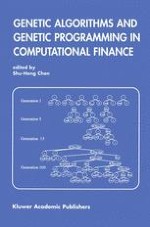2002 | OriginalPaper | Buchkapitel
Evolutionary Decision Trees for Stock Index Options and Futures Arbitrage
How Not to Miss Opportunities
verfasst von : Sheri Markose, Edward Tsang, Hakan Er
Erschienen in: Genetic Algorithms and Genetic Programming in Computational Finance
Verlag: Springer US
Enthalten in: Professional Book Archive
Aktivieren Sie unsere intelligente Suche, um passende Fachinhalte oder Patente zu finden.
Wählen Sie Textabschnitte aus um mit Künstlicher Intelligenz passenden Patente zu finden. powered by
Markieren Sie Textabschnitte, um KI-gestützt weitere passende Inhalte zu finden. powered by
EDDIE-ARB (EDDIE stands for Evolutionary Dynamic Data Investment Evaluator) is a genetic program (GP) that implements a cross market arbitrage strategy in a manner that is suitable for online trading. Our benchmark for EDDIE-ARB is the Tucker (1991) put-call-futures (P-C-F) parity condition for detecting arbitrage profits in the index options and futures markets. The latter presents two main problems, (i) The windows for profitable arbitrage opportunities exist for short periods of one to ten minutes, (ii) Prom a large domain of search, annually, fewer than 3% of these were found to be in the lucrative range of £500-£800 profits per arbitrage. Standard ex ante analysis of arbitrage suffers from the drawback that the trader awaits a contemporaneous signal for a profitable price misalignment to implement an arbitrage in the same direction. Execution delays imply that this naive strategy may fail. A methodology of random sampling is used to train EDDIE-ARB to pick up the fundamental arbitrage patterns. The further novel aspect of EDDIE-ARB is a constraint satisfaction feature supplementing the fitness function that enables the user to train the GPhow not to miss opportunities by learning to satisfy a minimum and maximum set on the number of arbitrage opportunities being sought. Good GP rules generated by EDDIE-ARB are found to make a 3-fold improvement in profitability over the naive ex ante rule.
